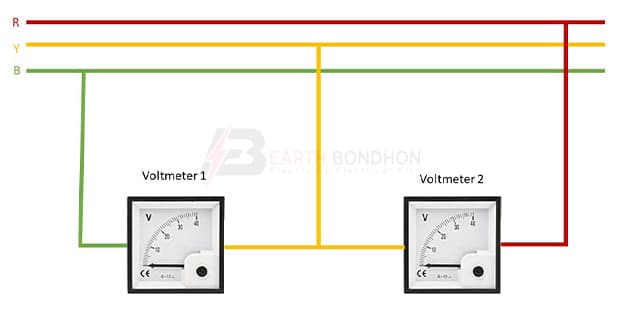Voltmeter Connection in 3 Phase Wiring Diagram:
This diagram shows Voltmeter Connection in Three Phase Wiring Diagram. This circuit diagram is very simple and easy to make connect it. In this circuit, we use two voltmeters. If you want to know more about this circuit, please check our youtube video below the post. For more information please check our category.
Advertisements
Components needed For this Project:
You can get the components from any of the sites below:
- single phase Volt Meter [See Buy Click Amazon]
*Please note: These are affiliate links. I may make a commission if you buy the components through these links. I would appreciate your support in this way!
Advertisements
Components used to make the Voltmeter Connection in 3 Phase Wiring:
An instrument that measures the potential difference between any two points in a circuit directly in volts is called a voltmeter. A voltmeter is an Electrical instrument that directly measures the potential difference between any 2 points in a circuit in volts. The voltmeter is connected in parallel with the 2 points in the circuit where the potential difference is to be measured. This instrument consists of a galvanometer. Like an electric cell or an ammeter, a voltmeter has 2 terminals, a positive and a negative terminal. Usually, the positive end is red and the negative end is black.
Thank You for visiting the website. Keep visiting for more Updates.
Frequently asked questions
Just connect the red to wire positive and black wire to negative to power supply the meter and then connect the yellow wire to the power supply source you want to measure, that's it! Great for monitoring voltages during development and debugging or as a permanent part of the project.
Thus, 3-phase system loads are designed to operate at the nominal voltage of 460 V with an overvoltage tolerance of 20 V. Both 460 V and 480 V were 3-phase voltages used for supplying industrial loads. Domestic systems, having lower power supply demands, operate with lower voltage levels.
In a 3-phase system, the line voltage is the potential difference between any 2 lines or phases; it was designated by V Line or V-L-L. If R, Y, and B represent the 3 phases (red, yellow, and blue), then the voltage difference between R and Y, Y and B, and B and R is the line voltage.
In a 3-phase system, there are three conductors, each carrying an alternating current with a phase difference of 120 degrees. This results in a more than efficient and balanced distribution of power supply, allowing for higher voltage levels such as 380 v.
To measure power supply in a three-phase system, it would seem necessary to use 3 wattmeters, each connected to neutral for a common terminal, and each responding to a line-to-neutral voltage and a line current. One would then add up the power supply indicated on each wattmeter.
Read more Single Phase Wiring
What is a kilowatt-hour (kWh) | kwh formula | What does kwh mean
Introduction to Electrical Units and CircuitskW and kWh on your electricity bill As your home uses electricity during...
What is the Difference Between kVA | What does KVA mean | kVA formula
Difference Between KVA ExplainedWhat does KVA Mean? There are technical terms aplenty when it comes to generators, and...
Power Factor | Power Unit | Energy | Electricity Unit
Power factor definition | Calculating Power FactorPower Factor Values In a purely resistive circuit, the power factor...


0 Comments